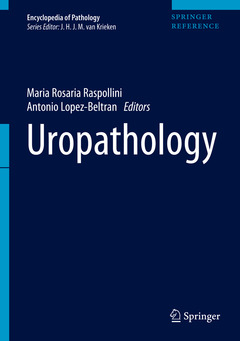Uropathology, 1st ed. 2020 Encyclopedia of Pathology Series

In addition to internationally respected experts on pathologies of the prostate, bladder, kidney and testis, researchers coming from other disciplines such as molecular biologists, soft tissue pathologists, dermatopathologists, hematopathologists and gynaecopathologists have contributed to this book, thus making it interesting for uropathologists, but also for students, residents, clinicians (surgeons, radiotherapists, oncologists, urologists, dermatologists) and researchers who deal with disciplines that call for knowledge of the pathologies of the male genital and urinary tracts.
Acquires cystic disease-associated renal cell carcinoma
Adenomatoid tumor
Adenomatous hyperplasia of the rete testis
Adrenal cortical rests
Amyloidosis
Angiomyolipoma
Angiosarcoma
Anorchism
Atypical small acinar proliferation
Autosomal dominant (adult) polycystic kidney disease
Autosomal recessive (infantile) polycystic kidney disease
Benign fibrous histiocytoma
Bladder cloacal extrophy
Bladder squamous cell papilloma
Calcifing nodules
Chondrosarcoma
Chromophobe cell renal cell carcinoma
Clear cell papillary renal cell carcinoma
Clear cell renal cell carcinoma
Complete androgen insensitivity syndrome
Condyloma and condyloma acuminatum
Congenital adrenal hyperplasia
Congenital mesoblastic nephroma
Crohn’s disease in the scrotum
Cryptorchidism
Cystic nephroma
Cystitis
Dermatofibrosarcoma protuberans
Diverticulosis of the bladder
Ectopia of the prostate
Embryonal carcinoma
Endocervicosis
Endometriosis
Endosalpingiosis
Epididymal adenocarcinoma
Epididymal cystadenoma
Epididymal melanotic neuroectodermal tumor
Epithelioid angiomyolipoma
Epithelioid haemangioendothelioma
Epithelioid sarcoma
Ewing sarcoma
Fibroepithelial polip
Fibrothecoma
Fournier’s gangrene
Germ cell neoplasia in situ
Germ cell tumors
Germinal cell aplasia
Giant cell fibroblastoma
Glomus tumor
Gonadal dysgenesis
Gonadoblastoma
Granular cell tumor
Granulosa cell tumor
Haemangioblastoma
Haemangioma
Haemangiopericytoma
Haematopoietic neoplasms
Hereditary leiomyomatosis and renal cell carcinoma-associated renal cell carcinoma
Hydrocele t
estisIdiopathic calcinosis
Idiopathic granulomatous epididymitis
Infarct of the prostate
Infectious disease of the testis
Inflammation of Littre’s glands
Inflammatory myofibroblastic tumor
Inverted urothelial papilloma
Juvenile xantogranuloma
Juxtaglomerular cell tumor of the kidney
Kaposi sarcoma
Kidney, normal histology
Leiomyoma
Leiomyosarcoma
Leydig tumor
Liposarcoma
Lithiasis
Lymphangioma
Malakoplakia
Male pseudoermaphrodism
Malignant peripheral nerve sheath tumor
Median raphe cysts
Medullary sponge kidney
Melanoma
Melanosis
Mesonephric remnant of the prostate
Mesothelioma
Metanephric tumors
Metaplastic condition of the bladder
Metastatic tumors
Mit family translocation renal cell carcinoma
Mixed and unclassified sex cord-stromal
tumors of the testisMixed teratoma and yolk sac tumor, prepubertal-type
Mucinous metaplasia
Mucoid cyst of the penile skin
Mullerian type tumors
Mullerianosi
Multicystic renal dysplasia
Multilocular cystic renal neoplasm of low malignant potential
Myofibrosarcoma
Myoid gonadal stromal tumor of the testis
Myointimoma
Naevus
Necrotizing granulomatous inflammation
Nephroblastic tumors
Nephroblastoma
Nephrogenic adenoma
Neuroendocrine tumors of the kidney
Neurofibroma
Oncocytoma
Ossifying renal tumor of infancy
Osteosarcoma
Ovarian epithelial-type tumors
Ovotesticular disorder of sex development
Paget disease
Papillary adenoma
Papillary cell renal cell carcinoma
Papillary urothelial carcinoma
Papillary urothelial neoplasm of low malignant potential
Paragangliom
aParatesticular fibrous pseudotumor
Pathology of male infertility
Penile adenosquamous carcinoma
Penile basaloid squamous cell carcinoma
Penile carcinoma cuniculatum
Penile clear cell sarcoma
Penile clear cell squamous cell carcinoma
Penile dermatosis
Penile intraepithelial neoplasia
Penile lymphoepithelioma-like carcinoma
Penile mixed squamous cell carcinoma
Penile papillary squamous cell carcinoma, NOS
Penile papillary-basaloid carcinoma
Penile pseudoglandular carcinoma
Penile pseudohyperplastic carcinoma
Penile sarcomatoid squamous cell carcinoma
Penile squamous cell carcinoma, usual type
Penile verrucous carcinoma
Penile warty carcinoma
Penile warty-basaloid carcinoma
Penis, normal histology
Perivascular epithelioid cell tumor
Persistent mullerian duct syndrome
Peyronie’s disease
Pleo
morphic sarcomaPolyorchidism
Post-surgical necrobiotic granulomas of urinary bladder
Proliferative funiculitis
Prostate, normal histology
Prostatic acinar adenocarcinoma, atrophic variant
Prostatic acinar adenocarcinoma, foamy gland variantProstatic acinar adenocarcinoma, microcystic variant
Prostatic acinar adenocarcinoma, mucinous variant
Prostatic acinar adenocarcinoma, pleomorphic giant cell variant
Prostatic acinar adenocarcinoma, pseudohyperplastic variant
Prostatic acinar adenocarcinoma, sarcomatoid variant
Prostatic acinar adenocarcinoma, signet ring-like variant
Prostatic basal cell carcinoma
Prostatic clear cell adenocarcinoma
Prostatic cystadenoma
Prostatic ductal carcinoma
Prostatic intraductal carcinoma
Prostatic intraepithelial neoplasia
Prostatic neuroendocrine tumors
Prostatic squamous tumor
Prostatic s
tromal tumor of uncertain malignant potentialProstatic urothelial carcinoma
Prostatitis
Regressed germ cell tumors
Renal clear cell sarcoma
Renal collecting duct carcinoma
Renal medullary carcinoma
Renal mixed epithelial and stromal tumors
Renal mucinous tubular and spindle cell carcinoma
Renal sinus lipomatosis
Renomedullary interstitial cell tumor of the kidney
Rete testis dysgenesis
Rhabdoid tumor
Rhabdomioma
Rhabdomyosarcoma
Schistosomiasis of the bladderSchwannoma
Sclerosing adenosis
Sclerosing lipogranuloma
Scrotal fat necrosis
Seminal vesicle, normal histology
Seminal vesicle adenocarcinoma
Seminal vesicle mixed epithelial and stromal tumors
Seminal vesicle squamous cell carcinoma
Seminoma
Sertoli cell tumor
Simple renal cyst
Solitary fibrous tumor
Spermatic cord adipocytic tumorsSpermatic cord cellular angiofibroma
Spermatic cord deep angiomyxoma
Spermatic cord desmoplastic small round cell tumor
Spermatic cord myofibroblastoma
Spermatic cord torsion and testicular infarction
Spermatic cord, normal histology
Spermatic granuloma
Spermatocele
Spermatocytic tumor
Splenogonadal fusion
Stone granuloma
Subepithelial hematoma of the renal pelvisSuccinase dehydrogenase-deficient renal cell carcinoma
Synovial sarcoma
Teratoma with somatic-type malignancy
Teratoma, postpubertal-type
Teratoma, prepubertal-type
Testicular regression syndromeTestis and paratestis, normal histology
Testis collecting duct and rete testis adenocarcinoma
Testis collecting duct and rete testis adenoma
Trophoblastic tumors
Tubulocystic renal cell carcinoma<
Unclas
sified renal cell carcinomaUndifferentiated pleomorphic sarcoma
Urachal carcinoma
Urethral accessory gland carcinomas
Urethral caruncle
Urethral polyp, fibrous type
Urethral polyp, prostatic type
Urethral polyps
Urinary tract adenocarcinoma
Urinary tract large cell neuroendocrine carcinoma
Urinary tract pure squamous cell carcinoma
Urinary tract small cell neuroendocrine carcinoma
Urinary tract squamous cell papillomaUrinary tract verrucous carcinoma
Urinary tract villous adenoma
Urinary tract well-differentiated neuroendocrine tumor
Urinary tract, normal histology
Urothelial carcinoma in situ
Urothelial carcinoma with divergent differentiation
Urothelial carcinoma, clear cell type
Urothelial carcinoma, giant cell type
Urothelial carcinoma, lipid-rich type
Urothelial carcinoma, lymphoepithelioma-like type
Urothelial carcinoma, microcystic type
Urothelial carcinoma, micropapillary type
Urothelial carcinoma, nested type
Urothelial carcinoma, plasmacytoid type
Urothelial carcinoma, poorly differentiated
Urothelial carcinoma, sarcomatoid type
Urothelial dysplasia
Urothelial papilloma
Urothelial proliferation of uncertain malignant potential
Vasitis nodosa
Verumontanum mucosal gland hyperplasia
Yolk sac tumor, postpubertal-type
Yolk sac tumor, prepubertal-type
Covers topics ranging from the normal histology of the genitourinary tract to pathological findings regarding diseases of the male urinary tract
Written by internationally respected experts in this field
All entries are arranged alphabetically
Date de parution : 05-2020
Ouvrage de 510 p.
17.8x25.4 cm
Disponible chez l'éditeur (délai d'approvisionnement : 15 jours).
Prix indicatif 421,99 €
Ajouter au panierThèmes d’Uropathology :
Mots-clés :
Polycystic Kidney diesase; Granular cell tumor; Leiomyoma; Paget disease; Rhabdomioma



